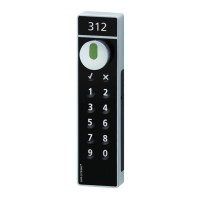
Do you have a question about the Schulte-Schlagbaum SAFE-O-TRONIC access LS101 and is the answer not in the manual?
| Brand | Schulte-Schlagbaum |
|---|---|
| Model | SAFE-O-TRONIC access LS101 |
| Category | Door locks |
| Language | English |
Key safety precautions and warnings for operating the locking system.
Information regarding the copyright and permissible use of this document.
Description of LS101/LSW101 keypad, OK, Abort, and number keys.
Procedure for initiating the programming process using key combinations.
Explanation of the capacitive keypad's function and operation.
How the system provides operator guidance via LED and sound signals.
Details on the security levels designed to prevent unauthorized access.
Instructions for performing a basic function check using the factory test code.
Step-by-step guide for the initial programming of the Master Code.
Important notes and rules for setting and managing the Master Code.
How to lock and unlock the system using the programmed Master Code.
Procedure for changing an existing Master Code for security.
Rules and recommendations for creating secure Master Codes.
Overview of available modes to configure locking system behavior.
How User PIN length affects Master Code requirements.
Table detailing allowed mode settings and corresponding PIN codes.
Information on the default mode set upon initial programming.
Step-by-step instructions for changing the system's locking mode.
Example of a mode for free cabinet selection with a 4-digit PIN.
Example of a mode for fixed cabinet assignment with a 6-digit PIN.
Example of a mode for fixed assignment with a 5-digit PIN.
Example of a mode specific to the LS101 variant.
Description of the 'one open' setting for fixed cabinet assignment.
Description of the 'all open' setting for fixed cabinet assignment.
Procedure for programming up to ten User PINs per lock.
Instructions on how to delete all entered User PINs from the lock.
How the lock automatically unlocks after a set usage duration.
How the lock automatically blocks after a set usage duration.
Overview of available time units and duration settings.
Step-by-step guide to changing the duration the lock remains active.
Configuration of LED status indicators and door recognition sensor.
Enabling and configuring alarm signals and buzzer alerts.
Table detailing configurable settings for the LSW101 system.
How to modify specific settings for the LSW101 system.
Explanation of LED displays for actions, modes, and error indications.
Guidance on identifying and resolving common operational problems.
Step-by-step instructions for replacing the battery in the LS101.
Step-by-step instructions for replacing the battery in the LSW101.
Information on low battery warnings and battery alarms for the system.
Details on the four possible mounting orientations for the LS101 unit.
Identification of parts and components required for LS101 installation.
Key considerations and tips for a successful LS101 installation.
Dimensions and procedures for drilling holes in the door for LS101.
Detailed steps for mounting the LS101 unit onto the prepared door.
How to adjust the direction of the rotary knob for locking.
Physical dimensions, weight, and technical data for the LS101.
Step-by-step instructions for installing the outer housing of the LSW101.
Procedure for fastening and connecting the inner housing of the LSW101.
Explanation of the sensing slide's role in door control and status indication.
Important tips and considerations for installing the LSW101 system.
Detailed dimensions for the inner and outer housings of the LSW101.
Technical specifications including display, battery, temperature, and protection ratings.
Guidelines for maintaining and cleaning the locking system.
Procedure for removing and replacing the identification plate.
Technical data and article numbers for LS101 and LSW101 battery packs.
Description of integrated battery management and low-battery signals.
Important safety precautions and procedures for battery replacement.
Instructions for the proper disposal of used battery packs.
Defines the intended applications and environment for the locking system.
Crucial safety guidelines, including original parts and avoiding modifications.
Statement of compliance with relevant EU directives and regulations.